Are you wondering if you can brew kombucha without white sugar or black tea? Do you want to brew kombucha with honey or herbal tea instead? Here’s everything you need to know to keep your SCOBY happy on an alternative diet.
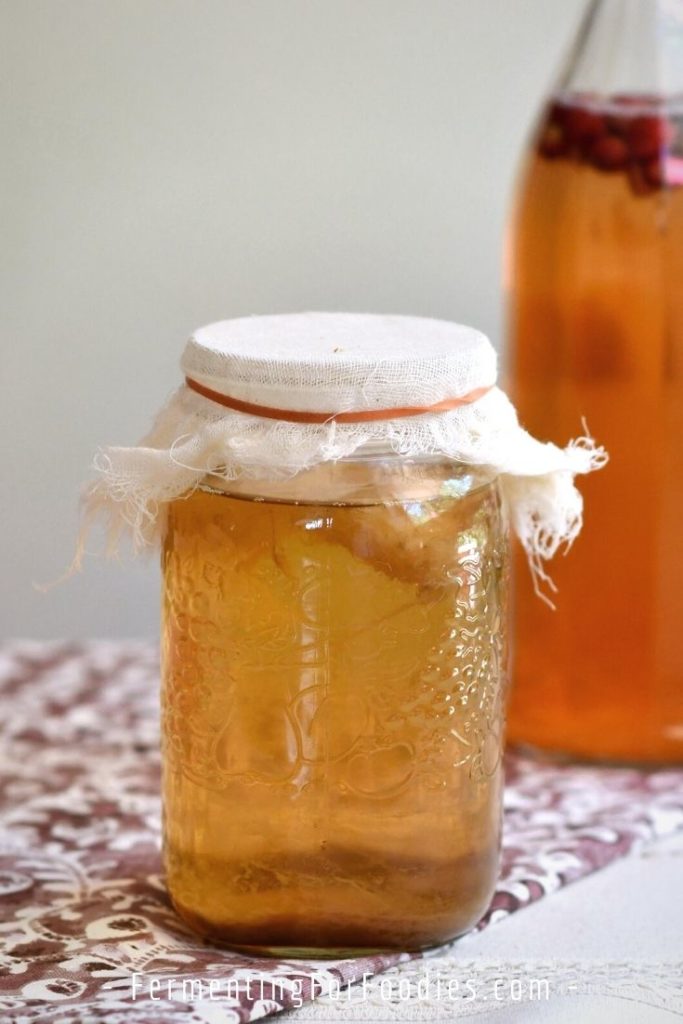
There is really only one trick to brewing kombucha without sugar or black tea… your SCOBY won’t be happy. The SCOBY needs the tannins found in tea and it needs sucrose to thrive. However, it is possible to brew kombucha with alternative sweeteners and tea.
Tips for Brewing caffeine-free, sugar-free kombucha
Your SCOBY won’t like being brewed without black tea or sucrose. Here is how to keep your SCOBY happy while you experiment:
- Refresh the SCOBY every other batch: To make sure that your kombucha is healthy, refresh the SCOBY by feeding it sugar and black tea, every other batch.
- Keep a backup SCOBY: Alternatively, keep a healthy SCOBY in the usual sweet tea as a backup. Then you can experiment as much as you want and you’ll still be able to return to making regular kombucha. If you brew kombucha regularly, then you probably have plenty of SCOBYs to experiment with.
- Make a jun SCOBY: It’s possible to turn a kombucha SCOBY into a jun SCOBY. Simply start brewing with green tea and honey. It takes a few weeks for the new jun SCOBY to grow, but eventually, it will!
Alternative Tea Options for Kombucha
Want to brew your kombucha without caffeinated black tea? Here’s what you need to know:
- Rooibos tea is better than other herbal teas because it doesn’t contain any volatile oils.
- Green tea and white tea are also good options.
- Decaffeinated black tea is probably the best option, as it contains the necessary tannins to feed your SCOBY.
- Avoid teas like mint, chamomile, rosemary, etc. which will harm the SCOBY. If you really want mint kombucha, then add mint-infused syrup when bottling.
How To Brew Kombucha with Alternative Sweeteners
Kombucha feeds on sucrose. So white sugar, brown sugar, coconut sugar, and panela will all feed your SCOBY.
Here’s some advice if you want to avoid sucrose sweeteners:
- Don’t use low-calorie sweeteners (like xylitol, stevia, Splenda) as there won’t be anything for the SCOBY to eat.
- Avoid high fructose sweeteners (like agave or rice syrup). You can add these sweeteners after bottling the kombucha for a second ferment. But not for the initial brew.
- A low-sugar kombucha can also be made with regular sugar. Just use about half the usual amount. The kombucha will be less sweet and less bubbly.
- Raw honey has its own yeast and bacterial culture. However, mixing the honey with boiling water will kill the natural yeast and bacteria. Otherwise, you may end up making mead instead of kombucha!
- Fruit juice also contains a mix of fructose and glucose. To sweeten with fruit juice use 1 cup of clear fruit juice (grape, apple, pear) with 2 cups of tea. The exact amount of sugar will depend on the type of juice. However, as long as you aren’t brewing with straight cranberry juice, the SCOBY should have enough fruit sugars to brew.
- Maple syrup can be used in the same way as honey. Just mix 1/4 cup into the tea.
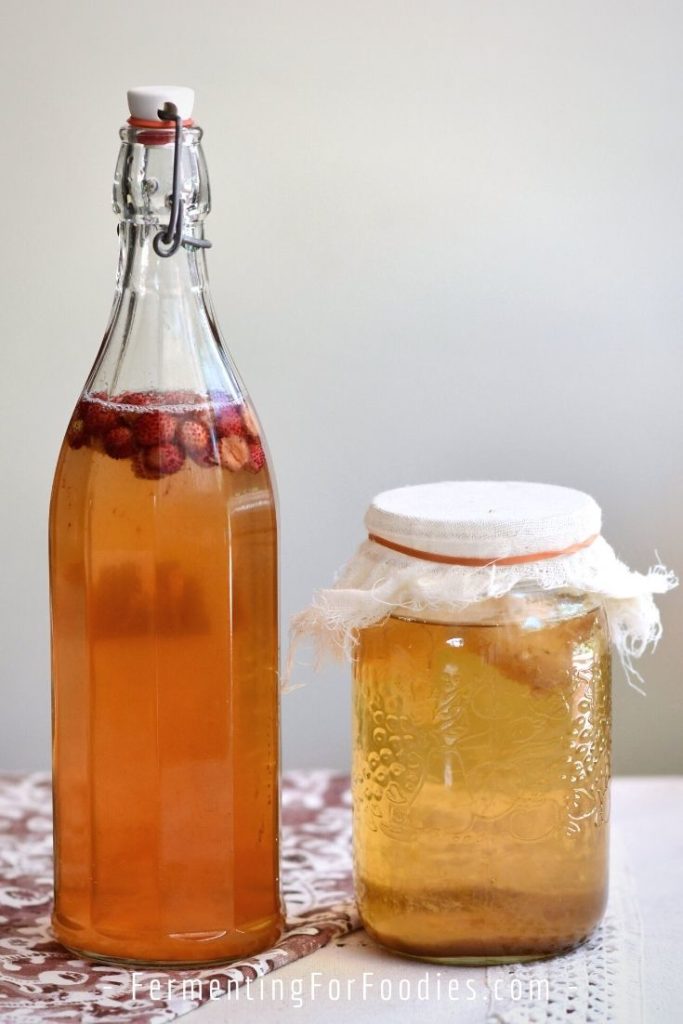
Rooibos Honey Kombucha
Want to make sugar-free kombucha, or avoid caffeinated tea? Here is how to make kombucha with herbal tea, honey, and other alternate sweeteners.
- Prep Time: 10 minutes
- Total Time: 10 minutes
- Yield: 4 1/2 cups 1x
- Category: Beverages
- Method: Fermented
- Cuisine: Probiotic
- Diet: Vegetarian
Ingredients
- 1 rooibos tea bag or 1 tsp of green tea
- 1/4 cup of honey (or other sweeteners, see section above for details)
- 3 cups of filtered water, divided
- 1 kombucha pellicle
- 1/2 cup of leftover brewed kombucha
Instructions
- Boil 2 cups of water and brew a sweet tea with rooibos and honey.
- Add the remaining cup of water. Allow the tea to cool down to room temperature.
- Place the brewed tea, SCOBY, and leftover kombucha in a large glass jar or measuring cup.
- Cover with a cloth or paper towel and use a rubber band to keep it in place.
- Allow it to ferment in a warm location for 4-9 days (it will take longer than regular kombucha).
- After 4 days, pour off a little liquid to taste it. It is finished when it has reached the desired level of sourness.
- When you like the flavor, it’s ready to be bottled! Pour the honey rooibos kombucha into a plastic bottle or a swing-top beer bottle. Either refresh the SCOBY in its usual sweet tea or use a fresh new SCOBY to brew another batch of honey rooibos kombucha.
- Kombucha brewed without sucrose (sugar) will be less bubbly. If you really want bubbles, prime the carbonation by adding 1/2 tsp of white sugar into the bottle. This will feed the kombucha enough to carbonate.
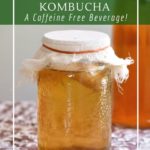
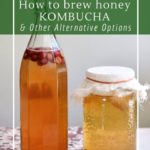
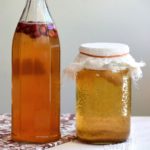
In the past when I was brewing beer. Pasteurized honey did not brew so well. I knew this and introduced raw honey into the boil pot to break down the sugars and sterilize bacteria. Has anyone else experienced this?
Boiling honey would kill the natural yeast and bacteria. I haven’t thought of adding it to beer! 🙂
I’ve been fermenting for three yrs. and just came upon your site. It and you are quite impressive, a little bit of everything. Thanx for the non dairy adds. I just restarted my kombucha (scoby from an unpasteurized purchase), I’ll be heading to you flavor page next. You’ve got me thinking about jun tea again. i always used to drink green tea but haven’t made jun yet. thannx for workin on my imagination and the inspiration Have you tried strawberry wine? 2lbs to a cup of sugar and gallon of water. 6- 10 days its like kvass.
Dave
Thanks! I have tried everything… and strawberry wine is one of those things. I will have to check that out. Cheers, Emillie
True! It is not diabetic friendly. It’s impossible to make kombucha without any sweetener to feed the ferment. However, this post was mostly about how to feed kombucha on non-sugar sweeteners (like honey) or fruit juice. If you’re looking for a diabetic-friendly fermented beverage, try my salty kvass, which is a salt-based ferment. Good luck!
Where do I purchase a Scoby? I’m enjoying your website. Thank you!
Probably the best way to buy a SCOBY is online. Depending on where you live, you may also be able to find one through community connections. People who make kombucha end up making a lot of extra SCOBYs!